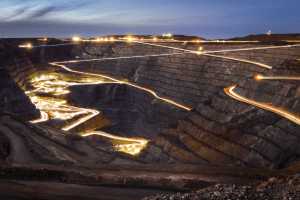In-situ mining is making a few shy beginnings in the mining industry. Also called in-situ leaching or solution mining, it is an innovative technique that leads to the extraction of valuable minerals from ore deposits without physically removing the ore from the ground.
But how is it possible and why do we believe this innovation is here to stay? Our engineers tell you everything.
With in-situ mining, less surface disturbances
Traditional mining practices have left indelible marks on landscapes, causing irreversible damage to the environment. In contrast, the emergence of in-situ mining offers a more ecologically sensitive approach to resource extraction. This technique operates beneath the Earth’s surface, eliminating the need for extensive excavation and preserving the natural terrain.
Goodbye, open pits? Not yet.
In-situ mining employs specialized methods such as solution mining and hydraulic fracturing. These techniques dissolve minerals in place, avoiding the need for disruptive digging and excavation. Unlike traditional mining, where large areas are laid bare, in-situ mining treads lightly, leaving landscapes visually unmarred. This presents a stark contrast to the scars left by open-pit mining, which reshape terrains and endure as lasting reminders of resource extraction’s toll on nature.
Furthermore, in-situ mining significantly reduces the financial burden of reclamation and rehabilitation projects. Traditional mining necessitates extensive restoration efforts to undo the damage caused by pit excavation and infrastructure development. These endeavours are not only costly but also time-consuming, delaying the land’s potential recovery. In-situ mining, on the other hand, avoids such disturbances, lessening the need for massive reclamation campaigns.
In the broader scope of a mine’s life cycle, pit reshaping stands out as a conspicuous aspect of traditional mining. The alteration of landscapes to access buried minerals transforms terrains into scars that persist long after operations cease. These scars alter the visual appeal of regions, affecting tourism, recreation, and local ecosystems. In-situ mining obviates these scars, promoting a future where resource extraction aligns with landscape preservation. As industries increasingly adopt in-situ methods, they pave the way for a more sustainable coexistence between mining and nature.
A Mining Solution Tailored to Specific Contexts
While in-situ mining holds promise as an environmentally conscious extraction method, it’s important to recognize that its applicability is not universal across all minerals and metals. The effectiveness of this technique hinges on several key factors, making it particularly well-suited for specific minerals that play pivotal roles in various industries.
In-situ mining finds its prime application in the extraction of minerals like gold, copper, and uranium. These elements hold immense significance in the context of renewable energy and technological advancement. Gold and copper are crucial components of electronic devices and renewable energy infrastructure, while uranium fuels nuclear power plants, contributing to low-carbon energy production.
The viability of in-situ mining is intricately tied to the permeability of the ore deposit and the presence of aquifers. A steady flow of water is essential for effectively extracting minerals using in-situ methods. The permeability of the deposit allows for the movement of solutions that dissolve or release the target minerals, facilitated by the presence of water. Aquifers further contribute to the process, ensuring a continuous supply of water that aids in mineral extraction.
However, it’s important to acknowledge that in-situ mining is not always feasible. In cases where the necessary conditions for in-situ extraction are absent, alternative mining methods come into play. Underground mining involves accessing minerals beneath the Earth’s surface through tunnels and shafts. Surface mining, on the other hand, involves removing layers of earth to access mineral deposits, often resulting in larger-scale landscape disruption. Placer mining targets minerals deposited in riverbeds and sediment, utilizing techniques such as panning and sluicing.
In essence, while in-situ mining presents a compelling solution for specific minerals, its effectiveness is tied to geological and hydrological factors.
Navigating Challenges in In-Situ Mining
In-situ mining is not perfect. It’s imperative to address certain challenges that arise within this innovative approach. Understanding and mitigating these issues are essential for ensuring the long-term viability of this method.
One key challenge lies in the training and education of the new generation of engineers entering the mining industry. In-situ mining demands a unique skill set that goes beyond traditional excavation methods. Engineers must grasp the complexities of subsurface processes, hydrogeology, and the interactions between leaching solutions and mineral deposits. Establishing comprehensive training programs that equip engineers with the expertise needed for in-situ mining will be crucial to maintaining its success.
Another concern centers around the unpredictable impact of leaching liquids on the rock within the deposit. Leaching involves introducing chemical solutions to dissolve target minerals. However, the reactions between these solutions and the mineral-bearing rock can yield unforeseen results, potentially leading to unintended environmental consequences. Extensive research and careful monitoring are essential to anticipate and mitigate any adverse effects on the surrounding ecosystem.
The challenge of restoring natural groundwater conditions after leaching operations is completed presents another hurdle. The intricate interplay between leaching solutions, mineral extraction, and hydrogeology can alter the natural flow of groundwater. Restoring this equilibrium post-mining requires innovative solutions that go beyond conventional reclamation practices, ensuring the long-term health of local water systems.
Addressing the treatment of mining sludge is also crucial. While significant progress has been made, with approaches like phytoremediation showing promise, effective and sustainable methods for managing the sludge generated from in-situ mining must be continually refined. The development of advanced techniques to treat, contain, or repurpose mining waste will contribute to minimizing the environmental impact of this extraction method.
In-Situ Mining; the perspective of an engineering consultancy
For an engineering consultancy, embracing in-situ mining represents a strategic decision driven by several compelling reasons. Here are key motivations that underscore the industry’s belief in this innovative extraction method:
- Environmental Stewardship and Reputation: In an era where sustainability is paramount, engineering consultancies recognize the importance of aligning their practices with eco-conscious values. By advocating for and implementing in-situ mining, consultancies showcase their commitment to responsible resource extraction. This proactive stance not only enhances their reputation as forward-thinking industry leaders but also positions them as agents of positive change in an environmentally conscious world.
- Technological Advancement and Expertise: In-situ mining demands a deep understanding of cutting-edge technologies, geology, hydrogeology, and chemical interactions. By championing this method, engineering consultancies position themselves as experts at the forefront of innovation. Their ability to navigate the complexities of in-situ mining demonstrates a high level of technical prowess, attracting clients who seek forward-looking solutions grounded in scientific rigour.
- Long-Term Viability and Resource Optimization: In-situ mining, with its reduced landscape disruption and minimized reclamation needs, aligns with long-term resource optimization. Engineering consultancies that advocate for this method showcase their dedication to sustainable solutions that balance resource extraction with preservation. This perspective resonates with clients who recognize the benefits of a steady and responsible approach to mining that maximizes resource availability for generations to come.
Engineering consultancies, like ours, champion in-situ mining for its alignment with values of environmental responsibility, technical expertise, and sustainable resource management. By embracing this method, we not only contribute to a greener future but also position ourselves as industry leaders who leverage innovation to drive positive change in the world of mining.
Follow us to learn more about innovation in the mining industry!




